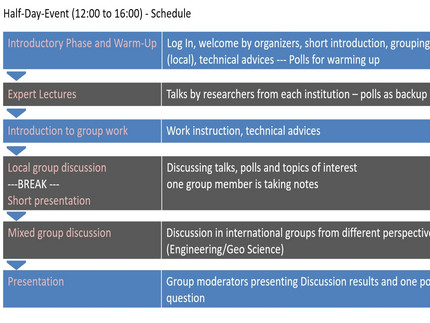Webmeeting - Social acceptance of CO2 sequestration and nuclear waste disposal
Lecturers
Dr. Katja Heeschen, Department Geochemistry of the Geo Research Centre Potsdam (GFZ) + Geosciences, University of Potsdam
Andreas Solders, Department of Physics and Astronomy, Uppsala University/Sweden
Partnering
- Lecturer exchange via Erasmus+ STT (Staff Training Mobility)
Collaboration format
PRE-COIL / Single Event
Katja Heeschen, first of all a researcher at GFZ Potsdam but also a teacher of geosciences at the University of Potsdam and in the ERASMUS exchange at the University of Uppsala Sweden initiated the cooperation. Together with a Swedish colleague they organized an online web meeting for students of two coursesatdifferent departments:
- Hydrogeology course (Geosciences, University of Potsdam, 12 Master students)
- Energy Systems course (Physics Department, University of Uppsala, 16 Bachelor students)
The one-time event, which lasted over 4 hours, involved 4 lecturers (1 presenter each; 1 guest speaker each) and one person responsible for media support each.
Objectives and topics of the course
The decisive idea for the cooperation of lecturers was the desire to experiment with media-supported teaching-learning scenarios that they had not yet tried out themselves and to make this experience possible for the students as well. In addition, the joint learning with students from other degree programs should
- open up new professional perspectives on topics that are not taught locally,
- integrate external expertise into local teaching in the form of guest lectures,
- demonstrate the importance and benefits of interdisciplinarity based on the web meeting topic, and
- enable exchange between subjects
Along the way, students gained experience with virtual collaboration and using a specific software application.
Didactic design
In preparation for the web meeting, a double-hour lecture was prefaced to introduce the topic. Two scientific articles on the topics (one article per university and guest lecture) were handed out for preparatory reading. Students were asked to pose a question on one article or on the topics in general and post it in the virtual classroom chat.
Also in preparation, information was provided about the meeting process and a video tutorial was provided on how to use Adobe Connect. In both student groups, a moderator was chosen to provide more detailed information about the web conferencing system.
The schedule of the web meeting was as follows:
Tools
Adobe Connect was used as web conferencing system. In addition, there were headsets for the students, several external webcams, and an external microphone for the presenters.
The following Adobe Connect features were used:
- Screen sharing and document upload
- layouts - for each phase of the web meeting, individual interfaces were designed and adapted to the teaching-learning activities
- participant management and breakout rooms for the group work phases
- Notepad and whiteboard for notes during group work
- survey tool for activating polls during/after the guest lectures and for feedback on the event
- chat for follow-up questions and group communication
Experiences
- Start small if you don't yet have any experience with collaborations.
- Experimenting pays off, even small events can generate valuable experience.
- The scenario is worth expanding to a multi-week collaboration. This would allow for broader familiarization and increased use of the benefits of interdisciplinarity.
- Particularly important for one-time events are:
- detailed planning, precise assignment of responsibilities, a backup plan, and sufficient time to set up and test the technology on the day of the event.
- If possible, provide separate rooms for larger groups at one location and planned group work periods.
- If Wi-Fi capacity is limited, better to use group video than individual cameras for each student.

